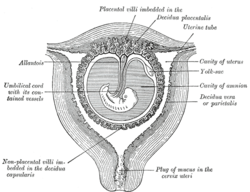Decidua basalis
| Decidua | |
|---|---|

Diagrammatic sections of the uterine mucous membrane: A. The non-pregnant uterus. B. Decidua parietalis; the mucous membrane] in the pregnant uterus and not beneath the placenta.
|
|

Sectional plan of the gravid uterus in the third and fourth month.
|
|
| Identifiers | |
| MeSH | A16.759.289 |
| Code | TE E6.0.1.4.0.0.7 |
|
Anatomical terminology
[]
|
|
Decidua is the term for the uterine lining (endometrium) during a pregnancy, which forms the maternal part of the placenta. It is formed under the influence of progesterone and forms highly characteristic cells.
The word comes from the Latin deciduus, meaning falling off or shedding.
After ovulation, in mammals, the endometrial lining becomes transformed into a secretory lining in preparation of accepting the embryo. Without implantation, the secretory lining will be absorbed (estrous cycle) or shed (menstrual cycle).
With implantation the lining now termed decidua evolves further during the pregnancy.
The decidua is shed during the parturition process.
Different layers of the deciduas have been described:
That part of the decidua that interacts with the trophoblast is the decidua basalis (also called decidua placentalis). The remainder of the decidua is termed the decidua parietalis or decidua vera. Also, there is the decidua capsularis, which grows over the embryo on the luminal side, enclosing it into the endometrium and surrounding the embryo together with decidua basalis.
The decidua has a histologically-distinct appearance, displaying large polygonal decidual cells in the stroma. These are enlarged endometrial stromal cells, which resemble epithelium (and are referred to as "epithelioid").
Formation of a specialized decidua is called decidualization, which is a special property of endometrium seen only in hemochorial placentation.
Decidualization includes the process of differentiation of the spindle-shape stromal fibroblasts into the plump secretory decidual cells, which create a pericellular extracellular matrix rich in fibronectin and laminin (similar to epithelial cells).
...
Wikipedia
